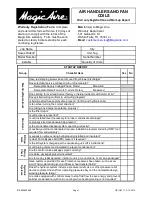
OPERATION AND MAINTENANCE MANUAL
DTR MCK v.2.4
PAGE
GDYNIA
MODULAR AIR HANDLING UNITS
MCKS, MCKH, MCKP
2017 EN
11/45
KLIMOR Spółka z ograniczon
ą
odpowiedzialno
ś
ci
ą
Sp.k., 81-035 Gdynia, ul. B. Krzywoustego 5
Fax: (+48 58) 783-98-88; Tel.: (+48 58) 783-99-99
Service -
Fax: (+48 58) 783-98-88; Tel.: (+48 58) 783-99-50/51 Mobile: (+48) 510 098 081
Information in this document is subject to change
email:
klimor@klimor.pl
-
office
serwis@klimor.pl
-
service
2.3.2.5 VF fan block
The task of this block is to force the air flow with a specific output and pressure.
The fan's power feed comes directly from the electric motor's shaft through the frequency converter (inverter).
Motor power: 1×230V or 3×400V 50/60Hz.
We use PF-type (plug-fan) fans without casing, with direct fan drive, with steel sheet or plastic rotors as well as direct
drive fans with EC motors.
The fan assembly is attached to a frame and it is fitted to the floor with shock absorbers. The fan's inlet flange is con-
nected to a suction chamber diaphragm with a flexible connector or rubber sealing. The flexible connector and rubber
sealing eliminates transmission of vibrations.
In case of smaller fans the inlet funnel is attached independently to the section diaphragm.
AHUs dedicated for external operation are equipped with the service switch which provides ON/OFF signal to the
AHU's control system.
Max. air temperature during the AHU operation is +60°C. Due to permissible operating temperature of the electric
motor, a power drop has to be considered in accordance with the following table.
Table No. 5
Power correction factor for electric motors, depending on the ambient temperature
Power correction factor depending on the ambient temperature
Max °C ambient temperature
40
45
50
55
60
P/PN %
100
97
93
87
82
2.3.2.6. SF fine filtration block
The task of this block is very thorough air filtration with the F-class bag filter (F7
÷
F9).
The bag filters are fitted in rails with gaskets and a strip clamp fasten with an eccentric connection mechanism. At the
filter replacement it is recommended to replace self-adhesive gasket attached inside the rail.
The S-class bag filters (H13÷H14) are attached in frames and they are pressed against them using the gasket and
bolt clamps.
Dimensions of applied filters are listed in the KT certificate
and at next pages of this OMM.
Electrostatic EF filters can be used as higher class filtration elements. Filtration efficiency and class depends on the
air flow in the filter window. The table below lists possible filtration classes.
The EF filters require 230V/50Hz power supply for so called generators.
Table No. 6
. Electrostatic filter classes depending on the air flow in the filter window
Air flow m/s
Filtration class
≤
3
EU7 (F7)
≤
2.5
EU8 (F8)
≤
2
EU9 (F9)
Electrostatic filters are composed of two main elements:
- filtration modules
- electronic module generating current with high voltage and very low current
Permissible operating conditions of the electrostatic filters:
- air flow temperature below 70°C
- air relative humidity at 15%÷98%
- size of eliminated particles: 0,01÷50 microns (it is necessary to install minimum EU4 class initial filter upstream the
electrostatic filter)
- no explosive components in the air being filtered
- no aluminum-corrosive components
Elements of electrostatic filters do not require replacement. They can be cleaned. The procedure is described
on next pages.
2.3.2.7 RR rotary heat exchanger block
In the RR assemblies heat recovery is achieved in a rotary heat regenerator, at 80% heat recovery efficiency. Re-
moved warm air flows through a rotor's part and it heats it up. The rotating rotor transfers the heat from that heated
part to cold air in the air-supply part. In summer it is also possible to recover cool and humidity. Rotary heat exchang-
ers can be used when some minor mixing of supplied and exhausted air is permissible.
There are available condenser heat exchangers for overt heat recovery as well as hygroscopic heat exchangers for
overt and latent heat recovery.







































